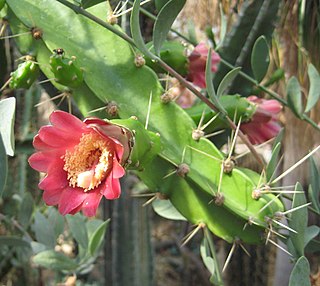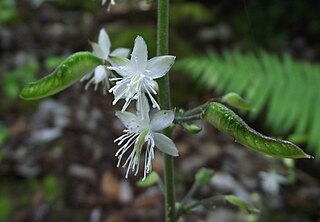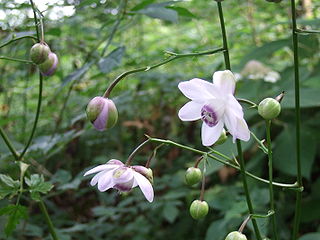
Anemone is a genus of flowering plants in the buttercup family Ranunculaceae. Plants of the genus are commonly called windflowers. They are native to the temperate and subtropical regions of all continents except Australia, New Zealand and Antarctica. The genus is closely related to several other genera including Anemonoides, Anemonastrum, Hepatica, and Pulsatilla. Some botanists include these genera within Anemone.

Ranunculaceae is a family of over 2,000 known species of flowering plants in 43 genera, distributed worldwide.

Delphinium is a genus of about 300 species of annual and perennial flowering plants in the family Ranunculaceae, native throughout the Northern Hemisphere and also on the high mountains of tropical Africa. The genus was erected by Carl Linnaeus.
In biology, a monotypic taxon is a taxonomic group (taxon) that contains only one immediately subordinate taxon. A monotypic species is one that does not include subspecies or smaller, infraspecific taxa. In the case of genera, the term "unispecific" or "monospecific" is sometimes preferred. In botanical nomenclature, a monotypic genus is a genus in the special case where a genus and a single species are simultaneously described. In contrast, an oligotypic taxon contains more than one but only a very few subordinate taxa.

Ranunculus is a large genus of about 1700 to more than 1800 species of flowering plants in the family Ranunculaceae. Members of the genus are known as buttercups, spearworts and water crowfoots.

Alstroemeriaceae is a family of flowering plants, with 254 known species in four genera, almost entirely native to the Americas, from Central America to southern South America. One species of Luzuriaga occurs in New Zealand, and the genus Drymophila is endemic to south-eastern Australia.

Calymmanthium is a monotypic genus of primitive tree-like cacti from northern Peru. The only species is Calymmanthium substerile. It belongs to the tribe Lymanbensonieae. Calymmanthium is absolutely unique among flowering plants in the mode of its floral development. The young flower is completely encased within the plant's stem until it is fully developed, at which time a crack develops in the stem, allowing pollinators access.

The Cimicifugeae are a tribe of flowering plants belonging to the family Ranunculaceae, based on the now obsolete genus Cimicifuga. The name Cimicifuga means "bed bug repeller".

Beesia is a genus of flowering plants in the buttercup family. It was named in 1915 after the plant nursery firm Bees of Chester, who financed the plant hunting trips of George Forrest and Frank Kingdon-Ward in China.

Itaya amicorum is a medium-size fan palm that is native to Brazil, Colombia and Peru. It is the only species in the genus Itaya. It was unknown to science until 1972, when it was discovered on the bank of the Itaya River in the Peruvian Amazon.

Ficaria is a small genus of several species of plants in the family Ranunculaceae, which were previously grouped with Ranunculus. The genus includes Ficaria verna, known as fig buttercup or lesser celandine, and related species. The name "Ficaria" is Classical Latin for fig. Plants in the genus are closely related to true buttercups, but generally have only three sepals and swollen smooth achenes.
Wendlandiella is a genus of one species of palms found in Peru, Bolivia and Acre state in Brazil. The genus is named after Hermann Wendland.

Anemonopsis, the false anemone, is a monotypic genus in the family Ranunculaceae, containing only the species Anemonopsis macrophylla, endemic to Japan's main island of Honshu. The generic name Anemonopsis refers to it being Anemone-like, and its specific epithet macrophylla means "large-leaved".
Caxamarca is a genus of flowering plants in the daisy family, Asteraceae.
Fulcaldea is a genus of flowering plants in the daisy family.
Misbrookea is a genus of South American plants in the groundsel tribe within the sunflower family. The genus is named in honour of Miss Winifred M. A. Brooke.

Krapfia is a genus of plants in the family Ranunculaceae, native to the Andes.
Leptopyrum is a monotypic genus of flowering plants belonging to the family Ranunculaceae. The only species is Leptopyrum fumarioides.
Metanemone is a monotypic genus of flowering plants belonging to the family Ranunculaceae. The only species is Metanemone ranunculoides.
Peltocalathos is a monotypic genus of flowering plants belonging to the family Ranunculaceae. The only species is Peltocalathos baurii.












